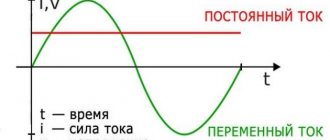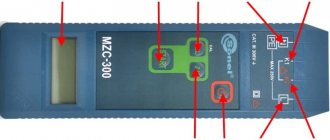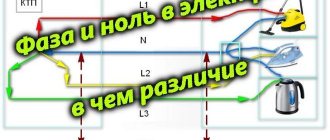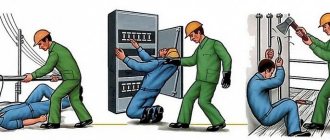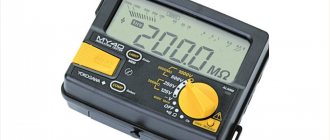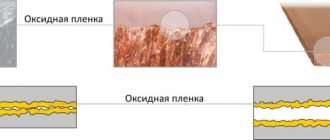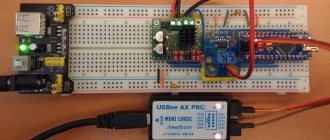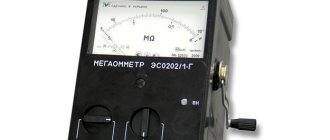Electrical appliances should work flawlessly if the electrical circuit complies with all norms and standards. But changes occur in power lines, which over time affect the technical parameters of the network. In this regard, it is necessary to periodically measure indicators and prevent power supply. As a rule, they check the performance of automatic machines, RCDs, as well as the parameters of the phase-zero loop. Below are details about the measurements, which instruments to use and how to analyze the results.
How the network is measured
To understand this, it is necessary to consider a circuit in which there is a consumer connected through a regular outlet. So, as mentioned above, phase and zero are supplied to the socket. In this case, there is a loss of voltage up to the outlet due to the resistance of the main cables and wires. This has been known for a long time; this process is described by Ohm’s formula:
R=U/I.
True, this formula describes the relationship between the magnitudes of direct electric current. To convert it to alternating current, you will have to take into account some indicators:
- Active component of network resistance.
- Reactive, consisting of a capacitive and inductive part.
What does it mean?
It is necessary to understand that the electromotive force that appears in the windings of the transformer forms an electric current. It loses its voltage when passing through the consumer and the supply wires. In this case, the current itself overcomes several types of resistance:
Instruments for measurements
You can measure the main indicators of the F-N circuit using two types of devices. The former can only be used after the voltage has been removed, while the latter can work under load. There are also differences in the amount of information displayed. Simple devices provide the values necessary for calculating Ik. A more complex design of the meters allows you to immediately display the value of Is.
Experts recommend using the following models of devices:
- MZC 300 is a modern microprocessor meter, the nuances of which we will describe below.
- M-417 - proved itself to be the best many years ago. Tests are carried out using the voltage drop method. In this case, the meter can be used under operating line voltage in networks with a solidly grounded neutral. The circuit under test opens in 0.3 s. You will need to perform calibration first.
- IFN-200 is designed for testing circuits with a resistance of up to 1 kOhm, with a permissible voltage from 180 to 250 V. In addition to measuring the F-N circuit, it is also capable of functioning in other modes. The IFN-200 memory can store data on thirty-five extreme calculations.
Resistance meter IFN-200
Measurement procedure using MZC-300
Before proceeding directly to the tests, we will briefly describe the adopted procedure, it includes:
- Compliance with certain conditions that ensure the necessary accuracy.
- Selecting a device connection method.
- Obtaining information about the network voltage.
- Measuring the main characteristics of the F-N loop.
- Reading the received information.
Let's look at each of the stages listed above.
Compliance with certain conditions
Some features of the meter should be taken into account:
- The device will not allow testing if the rated network voltage exceeds the maximum value (250V). Exceeding the measurement range (250.0 V) will result in an “OFL” warning being displayed on the device screen, accompanied by a long sound of the buzzer. In this case, the device should be turned off and disconnected from the loop being measured.
- If the neutral or protective conductors are broken, an error in the form of the “—” symbol will be displayed on the device screen, accompanied by a long buzzer signal.
- The voltage level in the loop being measured is insufficient for testing, usually if it is below 180.0 volts. In this case, the screen will display an error with the symbol “U”, accompanied by two beeps.
- Thermal blocking of the device is triggered. In this case, the “T” symbol is displayed on the screen, and the buzzer gives two long beeps.
Selecting a device connection method
Let's consider several options for electrical connection diagrams of the device for testing:
- Removing characteristics from the “F-N” loop; in the example shown in the figure, the parameters in the C-N circuit are measured.
C-N loop test - Measurement in a loop between one of the phases and the PE conductor.
C-PE loop test - Measurements in CT circuits.
Connecting the device in circuits with protective grounding
- To check the reliability of grounding of electrical equipment, the connection method given below is used.
Why check the resistance of the phase-zero loop?
Checking the resistance of the phase-zero loop is an important step in checking the functionality of the electrical network. This operation is performed to ensure a number of conditions:
- Installation of the required circuit breaker (RCD). The ability to accurately calculate the short-circuit current, which will ensure the selection of a machine that operates without delay.
- Selection of cable cross-section for solidly grounded neutral and phase conductor.
- Determining the need to install a stabilizing device in case of frequent fluctuations in alternating current in the network.
- Checking the possibility of ensuring selectivity during equipment operation.
- In many cases, when putting a cable line into operation, approval of electrical installation products is required from Rostekhnadzor authorities. Before issuing permitting documentation, responsible persons are required to provide protocols for measuring resistance on the phase-zero loop and other tests of the circuit.
From an economic point of view, checking the phase-to-zero resistance allows you to select the optimal electrical installation products without overpaying for extra indicators or cross-sections.
Test frequency
This test is carried out when putting electrical equipment into operation, without fail, during acceptance tests in 100% of the volume.
This allows you to determine how well the installation was done and the protection devices were selected. After this, the inspection is carried out every three years, and according to GOST R07 it is recommended to be included in the scope of operational tests. At the discretion of the person responsible for electrical equipment, tests can be carried out more frequently.
Who carries out loop measurements phase zero
Measurements are carried out by special electrical laboratories , whose activities are accredited by the Federal Service for Environmental, Technological and Nuclear Supervision. The right to carry out this type of work is indicated in the certificate of registration of the electrical laboratory in the list of works.
High precision instruments used
For phase measurements and calculations, both standard ammeters and voltmeters, the use of which is not difficult, or highly specialized instruments can be used. The latter ensure the highest possible accuracy of the obtained data on power grid parameters. The following measuring instruments are most widely used.
M417 is a reliable, proven device designed specifically for measuring resistance in a phase-zero circuit. One of the features of this device is the ability to carry out all work without removing the power, which greatly simplifies monitoring the state of the electrical network. This device uses the voltage drop method, ensuring the highest possible accuracy of the resulting calculations. It is allowed to use M417 in a circuit with a solidly grounded neutral and a voltage of 380 Volts. The only drawback to using this device is the need to calibrate the device before starting work.
MZC-300 is a new generation measuring device, which is based on a powerful microprocessor. The devices use a voltage drop method with a 10 ohm resistance connected. MZC-300 provides a measurement time of 0.03 seconds and can be used in networks with a voltage of 180-250 Volts. To ensure data accuracy, the device is connected to a distant point in the network, after which the Start button is pressed, and the result obtained is displayed on a small digital display. All calculations are performed by a microprocessor, which greatly simplifies phase control.
IFN-200 is a multifunctional device that allows you to perform phase measurements. The device operates with a voltage of 180-250 Volts. There are appropriate connectors to simplify connection to the network, and using this device does not present any difficulty. The limit on the measurement in the circuit is 1 kOhm, when exceeded, the protection is triggered and the device is turned off, preventing it from overloading. The device is based on a powerful microprocessor and has a built-in memory for the latest 35 calculations.
What determines the voltage and current during a short circuit?
Above I said that a short circuit can occur at any point on the line. Let's figure out how the current and voltage will depend on the location of the short circuit.
A short circuit is a physical phenomenon. Short circuit current is a parameter of the power supply network, measured in amperes or kiloamperes (kA).
The German physicist Ohm has taught us since school years that voltage and current are determined through the resistance of the circuit:
Short circuit current, like any current, is also calculated according to Ohm's law and depends on the voltage and resistance in a given section of the circuit. Since the resistance of wires in real life is not only what the multimeter shows, but also the inductive component, we will write Ohm’s law for short-circuit current in a more general form:
In the numerator U is the rated voltage in the network (no-load voltage at the output of the transformer at the transformer substation). The number that is obtained in the calculations in the denominator is the total resistance of the circuit Z, on which the short-circuit current depends. Let's consider a single-phase power supply circuit for an apartment and a real case of a short circuit with a shorted hair dryer:
Short circuit at the end of the supply line (minimum short-circuit current)
The diagram shows the impedances of various sections of the supply network:
- Z1 – internal resistance of the transformer at the substation, taking into account the recalculated resistance of the high-voltage part,
- Z2 – cable line from the transformer substation to the distribution point (DP) of the apartment building,
- Z3 – cable line from the distribution point to the apartment panel,
- Z4 – cable from the panel to the socket in one of the rooms,
- Z5 – carrying from an outlet to a closed hair dryer.
The hair dryer burned out and caused a short circuit
Here's what a voltage level graph might look like in different areas - from the terminals of a transformer at a substation to a shorted hair dryer plug:
Voltage drop to zero as a result of a short circuit at the end of the line
The voltage drop is accompanied by the release of heat in all parts of the supply line. In powerful sections with a large cross-section of wires, the share of the “indoor” short-circuit current is negligible, so the drop there is small (sections with resistance Z1, Z2).
Article about voltage drop. Calculation in low-voltage circuits and in DC circuits, without taking into account the reactive component.
In connection with the voltage drop as a result of a short circuit, it can be noted that this will be noticeable on parallel loads connected, for example, to the same RP. In the event of a short circuit or severe overload of one of the consumers, the light bulbs in neighboring houses and entrances will begin to burn dimmer. Has it happened?
And here’s what the change in short-circuit current from the source to the fault point might look like:
Decrease in current when moving away from the power source
The typical value of the short-circuit current at the terminals of a transformer with a power of up to 1000 kVA, which is used to power urban consumers, is about 10 kA. But in the sockets of our apartments, the short-circuit current can be about 1000 A. In the private sector and rural areas, the value of the short-circuit current can be much less - up to 100 A.
Transformer at a 10000/0.4 kV substation with a power of 1000 kVA with a solidly grounded neutral of the secondary winding. This is roughly what our “districts, neighborhoods, residential areas” are powered by.
Preparatory stage
Almost all methods of measuring the phase-zero circuit do not allow obtaining accurate information about such characteristics as ZP and ISC. This is due to the fact that the vector nature of voltage is not taken into account. Simply put, simplified short circuit conditions are taken into account. When testing electrical installations, such approximation is allowed only in cases where the level of reactance does not have a significant effect.
Before you begin measuring the characteristics of the F-N loop, you should first carry out a number of preliminary tests. In particular, check the continuity and resistance level of the protective lines. After this, measure the resistance between the ground loop and the main metal elements of the building structure.
FUSES
Fuses are electrical devices that protect installations from overloads and short circuit currents. The main elements of the fuse are a fuse-link, which is included in the cut of the protected circuit, and an arc extinguishing device, which extinguishes the arc that occurs after the insert melts.
The following requirements apply to fuses:
- The time-current characteristic of the fuse should be lower, but as close as possible to the time-current characteristic of the protected object.
- In the event of a short circuit, the fuses must operate selectively.
- The response time of the fuse during a short circuit should be as short as possible, especially when protecting semiconductor devices. Fuses must operate with current limitation.
- The fuse characteristics must be stable. Variations in parameters due to manufacturing deviations should not interfere with the protective properties of the fuse.
- Due to the increased power of installations, fuses must have a high breaking capacity.
- Replacing a blown fuse or fuse link should not take much time.
In industry, the most widely used fuses are type and PN-2.
Protocol on measurements of the “phase zero” circuit
Based on the measurements taken, a special protocol is drawn up. It is used to store recorded readings, as well as to carry out comparative analysis with subsequent tests.
The protocol displays the following information:
- the date of the;
- protocol number;
- purpose of testing;
- information about the organization conducting the tests;
- information about the customer;
- current climatic conditions: atmospheric pressure, temperature and humidity;
- measurement range, accuracy class and type of release;
- meter used for testing;
- recorded readings;
- test result;
- positions, names and signatures of the persons who carried out the measurements and checked the protocol.
Purposes of measuring the phase-zero loop
Electrical wiring fire protection
In order to prevent a fire from occurring in the event of a short circuit in the electrical wiring, automatic switches are installed in the electrical circuit, which we can see, for example, in an apartment panel. When a short circuit current flows, which is hundreds of times greater than normal, they turn off almost instantly (hundredths of a second).
In such a short period of time, nothing simply has time to “heat up and ignite”
A working machine operates at a current 5-10 times higher than the rated current, i.e., if it is marked C16, then instantaneous shutdown is guaranteed to occur at a current of 160A, and if C63, then 630A. If the short circuit current does not reach the operating threshold of the circuit breaker, it will not turn off instantly, but under the conditions of a current overload (5-30 seconds), which is certainly enough to ignite the surfaces in contact with the electrical conductor.
To ensure fire safety, it is necessary that the circuit breakers not only be in good working order, but also that the current during a short circuit is sufficient for instantaneous operation. You can check the actual short-circuit current only by directly measuring it with a device, which is colloquially called a “loop meter” (officially a “harmonic microohmmeter”).
Protection against electric shock from indirect contact
Based on the measured value of the single-phase short circuit current, the automatic operation time of the protective device is determined. This response time must be within the limits of the PUE Requirements (clause 1.7.79) for protection against electric shock during indirect contact by automatically turning off the power.
Frequency of inspections
The first maintenance is pre-commissioning, that is, it is applied before start-up, immediately after installation. There are no deadlines here, but you need to take into account that the sooner deviations during installation are identified (if they were made), the sooner you can demand compensation from the company that carried out the electrification of the entire facility. Otherwise, if everything is fine with the electrical installation, the resulting conclusion will serve as an official document according to which the device can be safely commissioned.
If subsequently there is no situation for prompt contact to our electrical laboratory, for example, the interest of a service company or the requirements of an electricity consumer, then a scheduled check must be carried out at least once every 2 years, subject to the aggressive environment in which it is used.
You can find out more detailed frequency by ordering a consultation with our expert.
Formulas for calculation
After taking measurements and recording the results in a protocol in the established form, it is necessary to carry out some calculations that will allow you to check the performance of the RCD and cable lines. Calculations are reduced to the use of standard electrical formulas, in accordance with the PUE:
- Phase-zero loop resistance formula:
Z = ZS + ZT / 3,
Z – the required value of the resistance of the phase-zero loop,
ZS is the total resistance of all cable cores included in the circuit,
ZT is the resistance of the transformer connected to the circuit.
- Expected current strength of the onset of a single-phase short circuit:
IKZ = UФ / Z,
IKZ – the required value,
UФ – rated voltage on the phase cable,
Z – phase-zero loop resistance value, determined by the formula given below.
- The protective automatic shutdown time of the RCD is a tabular value and should not exceed the following values:
UФ = 127 V, TNprev = 0.8 s,
UФ = 220 V, TNprev = 0.4 s,
UФ = 380 V, TNprev = 0.2 s,
UФ more than 380 V, TNprev = 0.1 s,
TNpre is the maximum permissible response time of the protective automatic shutdown of the RCD.
- Total ultimate resistance of the conductor providing protective shutdown of the RCD:
ZП = 50 Z/UФ,
50 is a constant characterizing the reduction in the rated voltage in the conductor in the section of the circuit between the grounding cable and the panel where the RCD is installed.
- Short circuit current, upon reaching which an automatic emergency shutdown occurs:
IKZ fact = UФ / ZП.
From the above formulas it is clear that the dependence of the calculation of each indicator is derived from the standard Ohm’s law in canonical form. Numerical values of the characteristics are taken based on the results of measurements taken, or determined from the tables given above. The phase-zero loop resistance formula is the main calculated value
Reading received information
Regardless of the type, model and modification of the device, the indicators are read from the interactive liquid crystal display after pressing the “Start” or “Test” button.
More expensive versions of the equipment are equipped with a large multi-line display, which displays all the necessary data at once. If the device has a small built-in display, the information on it is not completely displayed. To obtain all the information, you need to scroll through the screen by pressing the “Sel” or “Z/L” keys.
Some devices in the higher price category are equipped with a memory function for the last few settings, usually from 5 to 35 positions. This greatly simplifies the work of specialists at a large facility. Entering each measurement into the device’s memory allows you to postpone drawing up a protocol until the desk processing of full-scale tests of the electrical network begins.
Analysis of measurement results and preparation of the measurement protocol form
Based on the measurement results, the information obtained is entered into a protocol in the established form. This document is certified by an expert who has the necessary qualifications and clearance, after which it enters into legal force and is attached to the general folder for delivery of the object. The protocol contains the following information:
- Information about the company that carried out the measurements.
- Serial number, title and date of preparation of the paper.
- Official information about the test customer.
- Data justifying the need for measurements. This column indicates the purpose for which the work was carried out - acceptance of the facility into operation, periodic inspection, or testing after repair and replacement of electrical installations.
- Information about the climatic parameters in the room where the measurements were taken. If the test was carried out in relation to an external cable line, the parameters of the outside air on the day of testing are indicated.
- A table with measurement results, designed in accordance with the requirements of the PUE.
- Information about the instruments used during the tests, indicating the date of their verification.
- Conclusions of the expert commission.
The test report confirms the safe operation of the cable network and electrical equipment. When issuing a positive conclusion, the responsible person puts a personal signature, and a company representative certifies the paper with a blue seal, which indicates the responsibility assigned to the company.
Sample test report
Protocol No. ___
Checking the coordination of phase-zero circuit parameters with the characteristics of circuit breakers and the integrity of protective conductors
Climatic parameters, as of the date of testing
Air temperature ___ oC, Relative humidity __%, Atmospheric pressure ___ mm Hg. Art.
Purpose of measurements:
Regulatory technical documentation for compliance with which tests were carried out:
- Measurement results
| No. Pos. | Tested section of the circuit, installation location of the circuit breaker | Overcurrent protection device | Measured value of phase-zero circuit resistance, Ohm | Measured (calculated) value of single-phase fault current, A | Circuit breaker response time, sec. | ||||||||
| Typical designation | Trip type | Nom. current | Range current triggered release short short circuit | A | IN | WITH | A | IN | WITH | Maksim. permissible | According to the time-current characteristic | ||
| 1 | 2 | 3 | 4 | 5 | 6 | 7 | 8 | 9 | 10 | 11 | 12 | 13 | 14 |
| Power shield, No. 1 | |||||||||||||
| 1 | Group No. 1 | VA6730 | WITH | 10 | 50 – 100 | 0,6 | 366 | 0,4 | 0,01 | ||||
| 2 | Group No. 2 | VA6730 | WITH | 10 | 50 – 100 | 0,5 | 440 | 0,4 | 0,01 | ||||
| 3 | Group No. 3 | VA6730 | WITH | 16 | 80 – 160 | 0,4 | 550 | 0,4 | 0,01 | ||||
| 4 | Group No. 4 | VA6730 | WITH | 25 | 125–250 | 0,5 | 440 | 440 | 0,4 | 0,01 | |||
| 5 | Group No. 5 | VA6730 | WITH | 16 | 80 – 160 | 0,5 | 0,4 | 0,01 |
Conclusion: The parameters of the phase-zero circuit comply with the requirements of the PUE, clause No. 3.1.8, clause No. 1.7.79
The measurements were carried out:
Leading engineer EIL: Avilov / Avilov A. Yu.
Engineer EIL: Ivanov / Ivanov S. O.
The protocol was checked and approved by:
Head of EIL: Kochetkov / Kochetkov M. A.
Date __. __.____
General idea of the “phase zero” circuit
Most electricity consumers are powered by networks with a voltage level of up to 1 kV through a three-phase transformer. To ensure safety, they use a solidly grounded neutral. A current may appear in it due to a phase shift in the windings of the transformer, which are connected in a star circuit.
In the event of contact between the linear and neutral or protective wires, a “phase-zero” circuit is formed. This connection leads to the formation of a short circuit. The circuit may contain connecting wires, switching and protective equipment, which is accompanied by the formation of a certain resistance value.
What to do if the measured short-circuit current is too low?
Let's say we measured it with a device and got the value of the short-circuit current in the socket (as a rule, the measurement is carried out at the most remote point). How can you tell if this current is too low? This is assessed by the criterion of guaranteed operation of the electromagnetic release of the circuit breaker in the measured circuit. It is logical that for this the short-circuit current must be greater than the upper limit of the tripping range. Let me remind you that for characteristic “B” the spread is 3…5 In, for “C” – 5…10 In, for “D” – 10…20 In. To be more precise, let’s turn to the PUE (clause 7.3.139):
7.3.139. In electrical installations up to 1 kV with a solidly grounded neutral, in order to ensure automatic shutdown of the emergency section, the conductivity of the neutral protective conductors must be selected such that, in the event of a short circuit to the housing or neutral protective conductor, a short-circuit current occurs that is at least 4 times greater than the rated current of the fuse link of the nearest fuse and at least 6 times the current of the circuit breaker release, which has an inverse current characteristic.
When protecting networks with automatic circuit breakers that have only an electromagnetic release (without a time delay), you should be guided by the requirements regarding the short-circuit current multiplicity and given in 1.7.79.
As I understand it, the first part of 7.3.139 only talks about the thermal release - its rated current must be at least 6 times less than the short-circuit current. The second part of this paragraph, as well as paragraph 1.7.79, talks about the maximum shutdown time during a short circuit (0.4 s), which must be provided only by an electromagnetic release. At the same time, it is not clearly indicated on the choice of AV taking into account its shutdown characteristics.
Because of this vagueness of the wording, they use the rule set out in PTEEP (checking the operation of protection in a power system with a grounded neutral, clause 28.4), which states that when a short circuit to the neutral protective conductor occurs, the short-circuit current must be at least “1.1 the upper value of the operating current of the instantaneous release.”
That is, for a B10 circuit breaker, the short-circuit current at the end of the line that it protects must be at least 10x5x1.1 = 55 A. If a C25 circuit breaker is installed, the short-circuit current must be at least 25x10x1.1 = 275 A.
If the short-circuit current is less, the permissible response time is by no means guaranteed. What to do? There are two ways out:
- increase the short-circuit current, this requires the cost of laying a new supply line (at least its weakest link),
- reduce the rating of the machine (for example, 25 A to 16) and the letter of the shutdown characteristic (from “C” to “B”) to the detriment of the maximum load power.
What is a short circuit?
Many people know such a stable expression - “short circuit”. In addition to the name of a famous blockbuster from the 90s, the average person associates these words with a common cause of fires. There are many myths and cliches floating around on this topic. I decided to figure out what was what and why all this was needed.
A short circuit (SC) is a mode of operation of the electrical network, or a phenomenon in which the maximum possible current flows in the circuit at the point of the circuit. This event is difficult to predict and emergency, and the sooner it stops, the better. When a short circuit occurs, all the energy of the power source is spent only on heating the wires. In addition, dynamic (mechanical) consequences are possible. This process is usually very fleeting and explosive, since the thermal energy released is colossal. If you do not stop this disgrace as quickly as possible (we will look into how this is done below), then short circuit can lead to large material and human losses.
The shutdown time of household circuit breakers during a ground fault must be less than 0.4 s (PUE 1.7.79, 7.1.72). If the speed is not ensured due to low short-circuit current, shutdown should occur through devices that respond to differential current (RCD, RCBO), the response time will be (according to GOST) less than 0.04 s.
A short circuit can occur between any points in an electrical circuit that have different potentials. Here's what it looks like in three-phase form:
Short circuits in the power supply system with the TN-S grounding system. Who will see the error in the diagram?
The figure conventionally shows the secondary winding of a step-down transformer installed in a transformer substation (TS), a five-wire power line and a three-phase electrical installation. The electrical installation can be a private or apartment building, or maybe something industrial.
Closures can come in different forms:
- two- and three-phase (phase-to-phase),
- one-, two- or three-phase to neutral N or protective PE conductor.
If we consider the safest grounding system TN-S with a solidly grounded neutral of the transformer, then most often (in practice - about 90%) a single-phase short circuit occurs between the phase wire and the neutral N (or the protective conductor PE). Therefore, further we will consider a simpler, single-phase option:
Short circuit to neutral and protective conductors
I recommend my article: How three-phase voltage differs from single-phase. And linear from phase.
A short circuit can happen anywhere - even near a transformer substation (TS) due to the inattention of an excavator operator, or in an apartment because of a cat that dropped a Christmas tree. In any case, the protection must work clearly, minimizing the consequences of a short circuit.
By the way, our cat once dropped our Christmas tree. They threw her out of the 5th floor.
Circuit Resistance Testers
All modern electrical laboratories have meters. The devices reproduce a fake short circuit on a controlled section of the circuit or inside the unit, then immediately measure the resistance of the phase-phase, phase-zero loop (reactive, active, total electrical resistance).
The device instantly calculates the short circuit current without turning off the protection. This is how they check the correctness of the selected nominal value of the machine or fuse. At the same time, they determine the response time of the protection.
Devices help determine:
- values of transition resistances of switching devices (switches, circuit breakers, fuses, contactors, disconnectors, etc.);
- the exact trajectory of the electric current in the event of an accident (through steel pipes, metal water pipes, circuits, other pipelines with iron walls, grounding cable).
The box of devices has holders in the form of magnets, so they can be quickly fixed to steel walls. Paint on metal does not interfere with retention.
Features of the circuit breaker
The design of the device and the principles of operation of this protection are described in a separate article. I recommend checking it out.
The circuit breaker is designed to quickly remove voltage from the power circuit in the event of an overload or a short circuit.
Overload mode
The initial protection of the electrical circuit was previously carried out using a fuse, the fuse of which simply burned out and broke the electrical circuit under the thermal influence of the emergency current.
This function remains in the design of the circuit breaker. In it, it is implemented by a thermal release and provides overload protection, removing voltage from the protected area with a time delay. This is necessary to eliminate frequent shutdowns when transient processes occur from various switching circuits.
It is convenient to determine the operating area of the thermal release, as well as its second component, the shutdown electromagnet, using the time-current characteristic, which indicates the dependence of the response time on the magnitude of the emergency current passing through the contacts of the bimetallic plate.
Short circuit mode
When it occurs, the maximum possible power is applied to the circuit, the energy of which can melt metal wires or cause a fire. Therefore, in order to preserve the equipment, it is necessary to perform very fast power removal in thousandths of a second.
This is the task of the second component of circuit breaker protection: current cutoff, which is performed by an electromagnetic release.
Both machine protections operate autonomously, do not depend on each other, and have their own settings and settings. However, they are selected for a specific value of the operating rated current and are designed to ensure its normal passage without unnecessary, false shutdowns.
The principle of selecting a circuit breaker
When determining its technical capabilities, the following are taken into account:
- the value of the rated current in the network, which is significantly influenced by the condition of the electrical wiring and the loads connected to it;
- permissible overload mode;
- disconnecting capacities of possible emergency modes.
The algorithm for selecting a circuit breaker based on rated current, taking into account the features of the power supply circuit, is shown in the diagram.
It allows you to make a preliminary calculation of the necessary parameters of the circuit breaker and select its protective characteristics.
To carry out such a calculation, you can also use the Electric 7-8 computer program.
Calculation of short circuit current in a 0.4 kV network
Introduction
In accordance with clause 3.1.8. PUE electrical networks must have protection against short-circuit currents, ensuring the shortest possible shutdown time; it is indicated that the protection must be checked in relation to the smallest rated short-circuit current (hereinafter referred to as the short-circuit current) to the rated current of the fuse link or circuit breaker release. (For more information about choosing protection against short-circuit currents, read the article: Calculation of the electrical network and selection of protection devices)
Loop measurement order: zero
Measurement of the resistance of the phase-zero circuit can be carried out with or without removing the voltage. In most cases, they are performed without relieving tension.
Measurements without stress relief can be performed:
- In additional load mode. The phase-to-zero circuit is closed through an additional load. In this case, the voltage drop and current passing through the load are measured and the loop resistance is calculated.
- In short circuit mode. The closing time is a few milliseconds. This method is implemented in most modern devices.
Measurement technique
Measuring loop characteristics depends on the technique chosen and the instrument used. The most commonly used devices are those that directly measure the resistance of the phase-zero loop with further calculation of the predicted short-circuit current. For example, using IFN-200.
The device is connected to the operating circuit at the most distant point from the input panel. If it is not possible to determine the farthest point of the line, measurements are taken at all or several points of this line. Next, using the obtained values, the current of a possible short circuit is compared with the characteristics of the protection device.
In what cases are measurements taken?
Measurement of the resistance of the phase-zero circuit section must be organized in the following situations:
- when putting into permanent operation new, not yet operating power electrical installations;
- when the regulatory energy services received instructions to carry them out;
- according to the application of enterprises and organizations connected to the serviced electrical network.
When a power system is commissioned, loop resistance test measurements are part of a set of activities carried out to verify its performance. The second case is associated with emergency situations that often occur during the operation of power circuits. An application from certain consumers represented by an enterprise or organization may be received if the protection of the equipment is unsatisfactory (based on complaints from specific users, for example).

